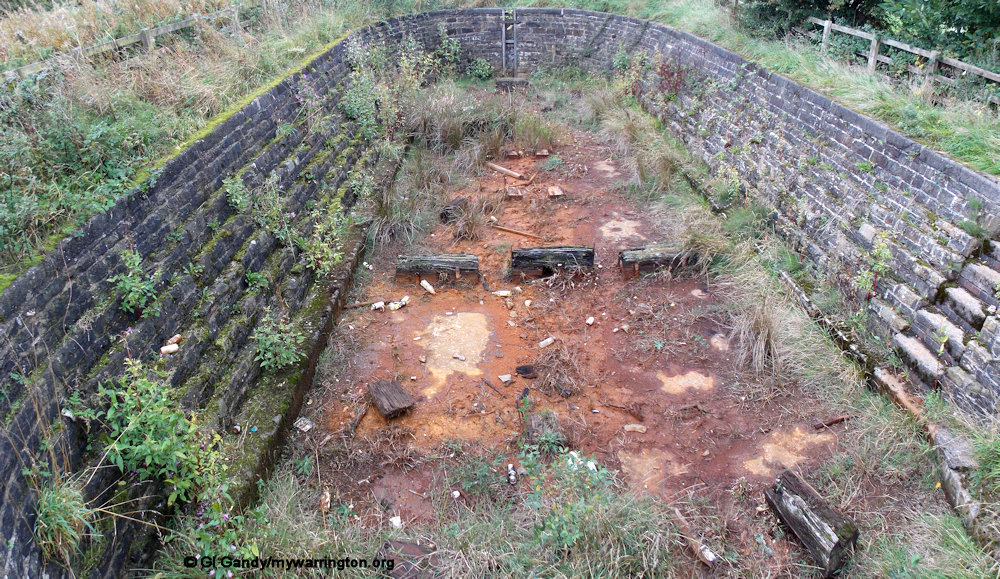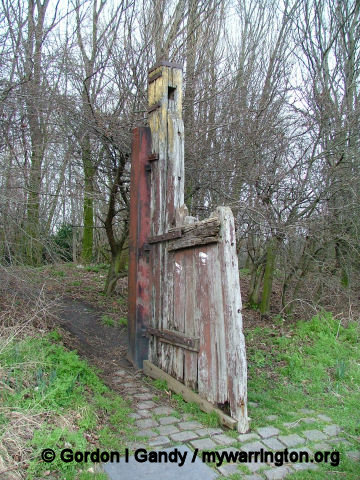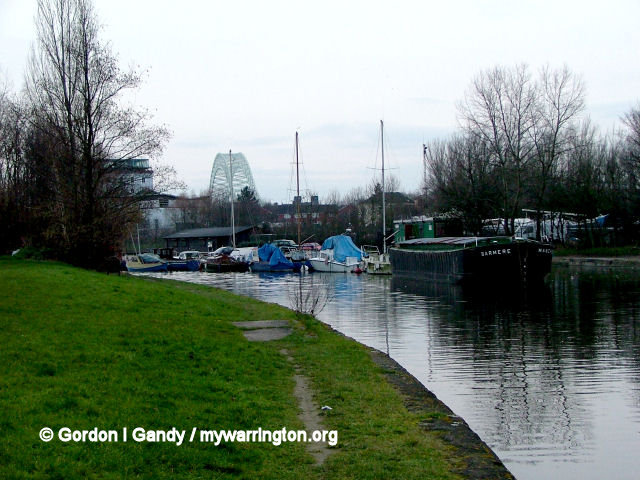
The Sankey Canal, initially known as the Sankey Brook Navigation and later the St Helens Canal, is a former industrial canal, which, when opened in 1757, was England’s first of the Industrial revolution, and the first modern canal.
The canal eventually connected St Helens to the River Mersey at Spike Island in Widnes. Originally it followed the valley of the Sankey Brook from the Mersey through Warrington to Parr following which extensions were constructed at the Mersey end to Fiddlers Ferry and then to Widnes, while at the northern end it was extended to Sutton.
The Sankey Canal was built principally to transport coal from Haydock Collieries and Parr to the growing chemical industries of Liverpool, although iron ore and corn were important cargoes. The industries rapidly expanded, and spread along the line of the canal to St Helens, Haydock, Newton le Willows and Widnes, which were small villages until this period. The canal was an important factor in the industrial growth of the region.
The line of the canal was surveyed by Henry Berry and William Taylor, for which they charged £66. It is not known whether Berry or the promoters presented the plans to parliament as an upgrade to the river navigation, despite building it as a true canal, but it is thought to be the only time a canal was authorised by parliament without anyone petitioning against it.

Sankey Brook at Winwick (17 Feb 2007)
During its construction a total of three acts of parliament were granted to the canal company.
First Act of Parliament
The first Act of Parliament authorising the construction of the navigation was passed on 20 March 1755. It was entitled “An Act for making navigable the River or Brook called Sankey Brook, and Three several Branches thereof from the River Mersey below Sankey Bridges, up to Boardman’s Stone Bridge on the South Branch, to Gerrard’s Bridge on the Middle Branch, and to Penny Bridge on the North Branch, all in the county palatine of Lancaster.” The canal was open and carrying coal by 1757; carriage of all goods was charged at a flat rate of 10d (ten old pence – £0.04) per ton. Upon its opening it became Britain’s first canal of the Industrial Revolution.

Sankey Brook at Dallam (17 Feb 2007)
Second Act of Parliament
A second Act of Parliament was obtained on 8 April 1762, amending the earlier act, and was entitled “An Act to amend and render more effectual, an Act made in the Twenty-eighth Year of the Reign of his late Majesty King George the Second, for making navigable Sankey Brook, in the county of Lancaster, and for the extending and improving the said Navigation”. This authorised the extension of the navigation to Fiddler’s Ferry on the River Mersey, and to take an additional toll of two-pence per ton, making the rate one shilling (£0.05) per ton. The line of this extension was surveyed by John Eyes, who acted as principal witness to see the bill through parliament.
An early trial of steam power took place on 16 June 1797, when, according to the Billing’s Liverpool Advertiser, dated 26 June, John Smith’s “vessel heavily laden with copper slag, passed along the Sankey Canal… by the application of steam only… it appears, that the vessel after a course of 10 miles [16 km], returned the same evening to St Helens whence it had set out”. The boat was powered by a Newcomen engine working a paddle crankshaft through a beam and connecting rod.
Third Act of Parliament
To counter competition from the new railways, another extension was planned from Fiddler’s Ferry across Cuerdley and Widnes Salt Marshes to Widnes Wharf, on the west bank of the River Mersey near Runcorn Gap, creating a second connection to the Mersey and another basin. This was authorised by a third Act of Parliament, granted on 29 May 1830, entitled “An Act to consolidate and amend the Acts relating to the Sankey Brook Navigation, in the county of Lancaster; and to make a New Canal from the said Navigation at Fidler’s Ferry, to communicate with the River Mersey at Widnes Wharf, near West Bank, in the township of Widnes, in the said county”, repeals the former acts of the 28th George II and 2nd George III and incorporates the proprietors under the title of “The Company of Proprietors of the Sankey Brook Navigation. “Francis Giles was appointed engineer for this extension, which opened in 1833. In 1825 Giles, who was a pupil of John Rennie and involved in many canal projects of the period, had proposed a link from the Sankey, via an aqueduct across the Mersey, to the Bridgewater Canal and the Mersey and Irwell Navigation, but this was never implemented.
Winwick Maintenance Yard and Dry Dock
The maintenance tard was built alongside the canal in 1841 to service the boats and to do other repairs. A crane lifted the boats from the canal and It had its own miniature railway to move coal to and from the boats. The building still stands today and is used by another company.
The dry dock was on the opposite side to the maintenance yard. boats would be moved into the dock and a lock gate cut off the water from the canal. A drainage culvert was opened to let the water out of the dock so that work can be done on the boats and when finished the lock gate was opened and the boat floated back into the canal.
You can read more about the Winwick section of the canal on the noticeboards in the area.





May I point you to the Sankey Canal Restoration Society website for more reading.
On the other side of the motorway are the remains of a lock, now filled in.



Hulme Lock



From St Helens, the Sankey Brook always flowed at a lower level than the Canal, which enabled it to overflow in heavy rain. Just past Hulme Lock the Brook flowed into the Canal and excess water drained through the sluices and into the Brook’s original course.

From St Helens, the Sankey Brook always flowed at a lower level than the Canal, which enabled it to overflow in heavy rain. Just past Hulme Lock the Brook flowed into the Canal and excess water drained through the sluices and into the Brook’s original course.
The images here show what remains of the sluices today (photos 17 Feb 2007)

Bewsey Lock
Her you can read about the history and workings of Bewsey Lock.
Click the first image and view a manual slide show at your leisure. Information provided by Warrington Borough Council and Sankey Canal Restoration Society.





Mersey Flats
The Sankey Canal was built for Mersey Flats, the common sailing craft of the local rivers; they were used on the Mersey, Irwell and Weaver and along the Lancashire and North Wales coasts. To allow for the masts of the flats, swing bridges were constructed where roads crossed the canal. When the railways were built, they too had to cross in similar fashion. The exception was near the newly built town in Newton-Le-Willows that was to become Earlestown, where George Stephenson erected the Sankey Viaduct for the Liverpool and Manchester Railway, leaving 70-foot (21 m) headroom for the flats’ sails.
The canal’s immediate commercial success, followed soon after by that of the Bridgewater Canal, led to a mania of canal building, and
for further extension schemes to be proposed for the Sankey Canal. Francis Giles’ proposal to link the canal to the Bridgwater Canal was not implemented, and neither was a plan to link the canal to the Leeds and Liverpool Canal near Leigh, to the North-East. Apart from the early extension to Fiddlers Ferry, which provided better access to the River Mersey, and the 1775 extension to St Helens, the only major change came with the extension to Widnes in the 1830s.
Built primarily to take coal from Haydock coal from Haydock and Parr down to the Mersey and so on to the saltfields of Cheshire and Liverpool, the final traffic on the Sankey Canal was very different, and in the opposite direction, consisting of raw sugar for the Sankey Sugar Works at Earlestown, Newton-le-Willows, from Liverpool.

View of the Sankey canal basin at Spike Island, Widnes circa 1850. Showing 3 Mersey flat boats, railway wagons, chimneys and factories. Author Desertarun1. Used under Creative Commons licensing CC0 1.0 Universal Public Domain Dedication


The length of a flat was from 62 to 70 feet long, with a 6-foot draught and a beam of 14 feet 9 inches to 17 feet. They could carry up to 80 tons of cargo.
To allow for the masts of the flats, all the roads in the Canal’s path had to cross it on swing bridges. When the railways were built, they too had to cross in similar fashion.
The exception was at Earlestown, where Stephenson erected his massive viaduct for the country’s first passenger railway from Liverpool to Manchester, leaving 70 foot headroom for the flats’ sails.
It is unclear exactly how the flats’ masts were accommodated at Great Sankey, where the Liverpool – Warrington – Manchester line built by the Cheshire Lines Committee in 1873 crosses the Sankey on a 12-arch viaduct less than twenty foot above the water level of the canal.

A wooden rudder from a Mersey Flat
at Spike Island, Widnes (18 Feb 2007)
This poem is from a grave at the entrance to Warrington Parish Church
The Old Quay Flats was my delight I sailed in them both day and night GOD bless masters and the Clerks The Packet people and the Flat Men too Horse drivers and all their crew Our sails are set to Liverpool We must get under way Discharge our cargo safe and Sound in Manchester Bay Now all hands when you go home Neither fret Cry nor Morn Serve the Lord where ever you go Let the winds Blow high and low

To our GOD let us pray keep us from
Drunkenness and wickedness both night and day
This stone and grave a free gift to John
Yates Mariner Captain of the Old Quay Packet.
——————————————————————–
GOD bless all British sailors, Admiral Nelson
And all the English fleet
When we must go we do not know
Sweet Jesus Christ to meet.
This grave is to John Legh
Mary his sister (Oct 6 1801 age 39yrs)
Betty his mother (6 May 1824 age 88y)
Decline
The ending of the sugar traffic in 1959 led to the closure of the Canal in 1963. North of the Sugar Works, closure had taken place between St Helens and Earlestown in 1931, and fixed bridges quickly replaced the old wooden swing bridges. The Canal, however, remains largely in water right up into the centre of St Helens, although its terminus had been truncated in 1898, when Canal Street was built over it.



Restoration
Restoration of the canal began in 1980, when work began on the section between Bewsey and Liverpool Road, Great Sankey, funded by a Derelict Land Grant. Most of the canal is still in water and much has been restored to navigable standard, with short sections at Fiddlers Ferry, Warrington and Spike Island, Widnes having locks into the Mersey which have allowed craft access to the canal for mooring since the locks were restored in the 1980s.
However, fixed bridges which replaced the original wooden swing bridges and other obstructions isolate the sections from one another. The route of the canal passes through the Sankey Valley Park and the towpath from Sankey Bridges to Widnes now forms part of the Trans Pennine Trail.
There are plans to restore the canal, and perhaps to extend it northwards to join the main canal system via the Leeds and Liverpool Canal. The total cost of this would be in excess of £100m and it is therefore a long-term project. There are, however, plans to dig out an infilled section in the centre of St Helens as part of the town’s Eastside development.
A feasibility study for this work was funded by a grant from the Single Regeneration Budget Fund, while at the other end of the canal, the Widnes Waterfront plan, published by Halton Council, and the new Mersey crossing between Widnes and Runcorn were expected to lead to further restoration at Widnes. One major obstacle is that the canal is severed by the A57 dual carriageway in Warrington.

Sankey Canal at Sankey Bridges



Some information from Wikipedia
For more history on the route of the canal, see the Sankey Valley Park page.















